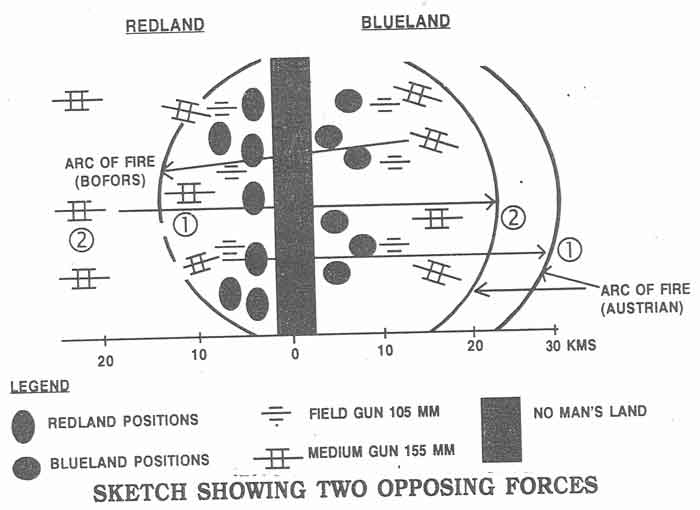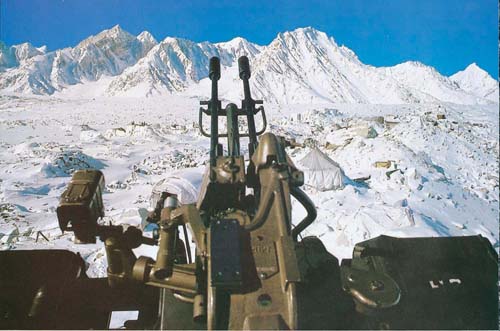Important factors considered by the TEC while comparing the characteristics of the four gun systems.
Range. During the 1981 trials in India, the Bofors achieved a range of 15 kms, during which, the firing mechanism and other components flew out of the breach. The Swedes asked for a little more time and hurriedly rushed in new components, but even then a range of only 21.5 kms was obtained. When the Swedish team was being interviewed by my Committee, I asked them specifically to state what the maximum range of the gun was. They stated categorically that it was 24 kms. So I asked if this range had been witnessed by any Indian Army officer. They said “Yes General more or less”.-I sat up at this reply and requested them to clarify for the benefit of my Committee, what the exact implication of the electrifying phrase “more or less” signified. The range achieved is an exact figure. It can be 15000, 21000, 23500, 24400 or whatever, but it cannot be “24000 more or less”
The Swedish answer was absolutely honest. When the guns were ready to fire, and the Indian officers were at the target end of the range, a message was received from the Control Tower that the artillery could not fire because the firing ranges and the target areas where the shells were to fall, had been thrown open for moose-hunting (the moose is one of the largest of the deer tribe).
The story was quite incredible, and showed a total lack of coordination by the Swedes an otherwise very efficient nation. The Indian officers present had not mentioned this startling fact to anyone in India, and for some unknown reason had not submitted a Delegation Report. Something with which I had taxed the DCOAS.
The Austrian gun fired upto 39 kms, and the French gun upto 30.5 kms. It was a tremendous achievement on the part of the Austrians to produce a gun capable of reaching 30 kms with a totally ballistic solution, Le, without a rocket booster. For this they manufactured a much larger chamber, thus’ substantially reducing breech pressures. For longer ranges in excess of 30 kms, and upto 39.5 kms they used special ammunition called the Base Bleed. In order to reach 30 kms the French used rocket assisted ammunition. Both these guns therefore outgunned by large margins the Swedish gun which conferred immense tactical advantages on the two former weapons. The following sketch will amplify the position.
There are two opposing forces namely Blueland and Redland. If Redland has the Austrian gun, and Blueland has the Bofors, then Redland can move its guns from position No.1 back to position No.2, and still reach deep into Redland territory, while remaining out of range of the Redland guns. As such the Redland guns will always be unable to engage the Blueland guns once they have been moved back. This situation is amplified in the sketch.
Without moving his Austrian or for that matter, French guns which we know had much longer ranges than the Bofors, the enemy could from a greater distance, bombard bur own positions including our Bofors guns, forcing our guns to move constantly from one position to another while the enemy remained in his original position. Thus making us dance incessantly and rather uncomfortably to his tune.
 Weight of Projectile. The Austrian gun fired the heaviest shell. The French shell was also marginally heavier than the Bofors one. Combine this with the first factor. With far longer ranges each had a more devastating lethal punch.
Weight of Projectile. The Austrian gun fired the heaviest shell. The French shell was also marginally heavier than the Bofors one. Combine this with the first factor. With far longer ranges each had a more devastating lethal punch.
Mobility and Stability. All the guns on offer had their own Auxiliary Power Units (APUs). The Swedish and French guns travelled under their own power at 8 kmph, but the Austrian gun travelled at 34 kmph something which Sundarji had seen for himself when he drove the gun in Austria. It carried enough fuel to move 130 kms under its own power.
The Swedish gun had a height of 2.82m (with the French one slightly lower) and was mounted on four wheels, two very large ones, and two for the trailing arms. It had a high centre of gravity making it unsteady on broken ground. As far as this point is concerned the French gun was very similar to the Bofors. Both these guns could only move slowly across country because of their high centres of gravity, and APU s of limited power.
On the other hand, the Austrian gun had a height of 2.05m. It was mounted on six wheels, with four ordinary truck-sized wheels carrying the gun platform, and two smaller ones for the trailing arms. For movement in slushy or sandy areas, two of the main wheels on either side could be connected together with tracked chains almost like tank tracks giving much more traction, and hence greater mobility. Combine all these factors, and add one more in favour of the Austrian gun. While moving under its own power, six crew members and six rounds of ammunition could be carried. So it moved to its new position at great speed, and came into action well before the Bofors gun arrived.
Silhouette. We will examine this from the practical and tactical points of view, in conjunction with the third factor given above. A high silhouette is more difficult to hide especially in the desert, since it entails much more digging down. Hence greater time and effort is required to conceal the guns. The Austrian gun was the lowest. A gun is given its own APU to enable it to fire a few rounds, and then move as quickly as possible to another firing position. In an engagement involving medium or other long range artillery with an active enemy radar, or to counter active air strikes, the aim should be to change position quickly if detected, by moving to another position. If the gun-towing tractors cannot come up immediately to the initial gun position for some reason or the other, the gun may have to move to a second or a third position under its own power. To move cross-country for 1000m, the Bofors at 6 kmph (maximum speed 8 kmph) would take 10 minutes, and the Austrian gun at 24 kmph (maximum speed 34 kmph) would take only 2.5 minutes, thus enabling the Austrian gun to come into action in its new position much before the Swedish gun arrived and, if digging was required, dig a position quicker than either the Bofors or French guns, because of its lower silhouette.
Rate of Fire. This factor must be considered in conjunction with the previous factors and covers the much vexed question of “Burst Fire”. The Bofors gun had the ability to be able to fire three rounds kept in a tray ready to be fired one after the other, in a total time of 12/15 seconds. This was called Burst Fire. It could do two Burst Fires i.e. a total of 6 rounds in 25 to 36 seconds, and thereafter 6 rounds Burst Fire every other minute for 20 minutes. This method was enforced to prevent overheating of the gun barrel.
 Thus the Bofors could fire 60 rounds in 20 minutes or a total of 3 rounds per minute. The Austrian gun could do a Burst Fire in 16 seconds, and in 20 minutes file 40 rounds at normal rate, and 140 rounds in 20 minutes at its maximum rate of fire. I fought against the loose use of this term, because “Burst Fire” conferred an advantage of four seconds for only the first three rounds, and at that time still being in service I had to be careful with my choice of words. Eventually when Sundarji came out with outrageous claims for the Bofors “Burst Fire” capability and “Shoot and Scoot” (an unoriginal term purloined from American professional magazines) I had to protest openly and called these Sundarji’s “Red Herrings”. Later on he told the JPC, as quoted in the Hindustan Times on 1 May 88 that the Bofors gun was chosen to counter the American ground radar ANTPS 37 acquired by Pakistan, which brought about a “sea-change” to India’s vulnerability, and induced the Defence Ministry to order the Bofors gun!!
Thus the Bofors could fire 60 rounds in 20 minutes or a total of 3 rounds per minute. The Austrian gun could do a Burst Fire in 16 seconds, and in 20 minutes file 40 rounds at normal rate, and 140 rounds in 20 minutes at its maximum rate of fire. I fought against the loose use of this term, because “Burst Fire” conferred an advantage of four seconds for only the first three rounds, and at that time still being in service I had to be careful with my choice of words. Eventually when Sundarji came out with outrageous claims for the Bofors “Burst Fire” capability and “Shoot and Scoot” (an unoriginal term purloined from American professional magazines) I had to protest openly and called these Sundarji’s “Red Herrings”. Later on he told the JPC, as quoted in the Hindustan Times on 1 May 88 that the Bofors gun was chosen to counter the American ground radar ANTPS 37 acquired by Pakistan, which brought about a “sea-change” to India’s vulnerability, and induced the Defence Ministry to order the Bofors gun!!




